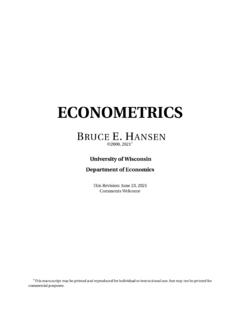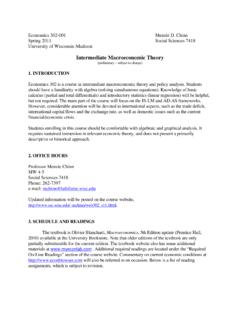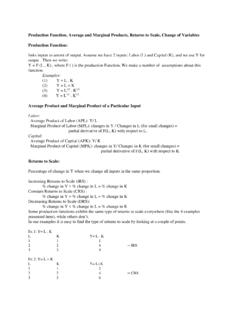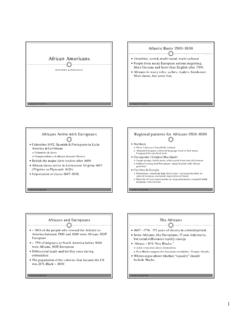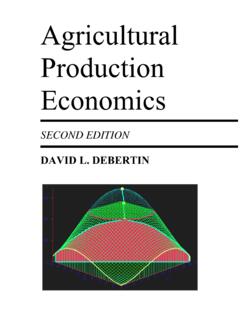Transcription of Problem Set 2: Solutions Problem 1 (Marginal Rate of ...
1 Problem Set 2: SolutionsECON 301: Intermediate MicroeconomicsProf. Marek WeretkaProblem 1 (Marginal Rate of Substitution)(a)For the third column, recall that by definitionMRS(x1, x2) = ( U x1)( U x2).Utility Function U x1 U x2 MRS(x1, x2)MRS(2,3)(i)U(x1, x2) =x1x2x2x1 x2x1 32(ii)U(x1, x2) =x31x523x21x525x31x42 3x25x1 910(iv)U(x1, x2) = 3 lnx1+ 5 lnx23x15x2 3x25x1 910(b)MRS(2,3) = 9/10 for utility functionU(x1, x2) =x31x52has the following interpre-tation: At bundle (2,3), to remain indifferent about the change ( , remain at the sameutility level), a consumer is willing to give up 9/10 ofx2for one additional unit ofx1. (Or,after losing one unit ofx1, he must receive 9/10 of a unit ofx2to be as well off as he wasat bundle (2,3).)
2 Soat the point(2,3), good two is more valuable since he needs to get lessof it than he lost of the other good to remain as satisfied. If of good one is takenaway, he would have to receive approximately (910) = units of good twoto remain indifferent to the change.(c)The two utility functions share the same MRS functions becauseU(x1, x2) = 3 lnx1+5 lnx2is a monotonic transformation ofU(x1, x2) =x31x52. To see this, letf(u) = ln(u)(f(u) is a monotonic function). Then lettingu=x31x52, we have thatf(u) = ln(x31x52) =3 lnx1+ 5 lnx2. If one function is a monotonic transformation of another, the two describethe same preferences since they will they rank bundles in the same way. (They assign dif-ferent values to the bundle, but we do not use thesecardinalnumbers in determining theutility-maximizing choices we only care aboutordinalcomparisons.)
3 Problem 2 (Well-Behaved Preferences)(a)Instead of using utility functionU(x1, x2) =x31x12, we can use a monotonic trans-formation instead:U(x1, x2) = 3 lnx1+ lnx2. (To get this, letf(u) = ln(u). Thenf(u) = ln(x31x2) = 3 lnx1+ lnx2. Again, even though these are not the same utility func-1tions, they ll give the same MRS and thus the same results.)UsingU(x1, x2) = 3 lnx1+ lnx2, we get thanM U1= U x1=3x1andM U2= U x2=1x2. SinceMRS(x1, x2) = MU1MU2= ( U x1)( U x2), we have here thatMRS(x1, x2) = 3x2x1. This is the MRSfor any bundle (x1, x2), which is also the slope of the indifference curve passing through thatpoint.(b)Using our answer in(a), we get thatMRS(1,1) = 3 11= 3. This tells us that theslope of the indifference curve passing through the point (1,1) is 3:DVDs,x1 CDs,x211 MRS= 3At (1,1), good one is locally more valued since, to compensate for a loss of 3 units of goodtwo (the CDs), Alicia only needs 1 unit of good one (the DVDs) to maintain the initial levelof happiness.
4 (c)The two secrets of happiness for well-behaved preferences are: (1)p1x1+p2x2=m(Since more is preferred to less, spend all of your income.) (2)MRS= p1p2 (Marginal utility per dollar spent is equalized.) Note: An equivalent way of writing this is MU1MU2= p1p2(using the definition ofMRS) orMU1p1=MU2p2. All three ways are exactly the , we re finding the bundle for which the budget line is tangent to an indifferencecurve:2 DVDs,x1 CDs,x2mp1=20mp2=401015 Given thatp1= 40,p2= 20, andm= 800, we can rewrite these two equations as (1)40x1+ 20x2= 800 (2) 3x2x1= 4020= x2=23x1(d)To find Alicia s optimal bundle, we just use the two equations above to solve for ourtwo unknowns, which arex1andx2. (So there s no economics here, only Algebra.)
5 You canjust takex2=23x1from equation(2)and plug it into(1)to get 40x1+ 20(23x1) = 800 = x1= 15. Plugx1= 15 into either equation to find thatx2= 10. Alicia s optimal bundle,given these prices and her income, is (15,10), which is interior (she s consuming non-zeroamounts of both). This is shown in the figure 3 (Perfect Complements)(a)The indifference curves passing through (5,1), (10,10), and (15,4) are shown below. Thevertices all fall along the dotted line along whichx2= 5x1. (It shows the combinations forwhich Trevor consumes five times as many strawberries (x2) as he does units of milk (x1)).The MRS at each of these points (without using any formulas and only looking at the graph)is zero:MRS(5,1) =MRS(10,10) =MRS(15,4) = (5,1)(15,4)(10,10)Milk,x1 Strawberries,x23(b)His preferences can be represented by the utility functionU(x1, x2) = min{5x1, x2}.
6 Ingeneral, if preferences are perfect complements whereaofx1must be consumed for everybofx2, the utility function can be expressed asU(x1, x2) = min{1ax1,1bx2}, and the line alongwhich all of the vertices of those L-shaped indifference curves lie is1ax1=1bx2. So using thisformula directlyU(x1, x2) = min{x1,15x2}but, multiplying everything through by 5 (whichwould be a monotonic transformation!) we getU(x1, x2) = min{5x1, x2}.To find the level of utility associated with the indifference curves passing through (5,1),(10,10), and (15,4), we use this utility function to find that: U(5,1) = min{5 5,1}= min{25,1}= 1 U(10,10) = min{5 10,10}= min{50,10}= 10 U(15,4) = min{5 15,4}= min{75,4}= 4x2=5x1(5,1)(15,4)(10,10)Milk,x1 Strawberries,x2u=1u= 10u=4 Notice that if you would have used utility functionU(x1, x2) = min{x1,15x2}, you would get: U(5,1) = min{5,15 1}= min{5,15}=15 U(10,10) = min{10,15 10}= min{10,2}= 2 U(15,4) = min{15,15 4}= min{15,45}=45 Either way, we see that (10,10) is the most preferred ( , gives the highest utility amongthe three), followed by (15,4) and then (5,1).
7 (c)Multiplying our utility function by ten and adding two is equivalent to taking a monotonictransformationf(u) = 10u+ 2. If we take our utilityU(x1, x2) = min{5x1, x2}, we getUtrans(x1, x2) = 10 min{5x1, x2}+ 2. Then U(5,1) = 10 min{25,1}+ 2 = 10 1 + 2 = 12 U(10,10) = 10 min{50,10}+ 2 = 10 10 + 2 = 102 U(15,4) = 10 min{75,4}+ 2 = 10 4 + 2 = 424 Again, the indifference curves do not move and the preference ranking among the bundlesis preserved, we just have the above levels of utility attached to each of the indifference curves.(d)Lettingp1= 1,p2= 1, andm= 100, the two secrets of happiness for perfect comple-ments are (1)p1x1+p2x2=m= x1+x2= 100 (Trevor spends all of his income.) (2)x2= 5x1(He consumes only to optimal proportions along the dotted line alongwhichx2= 5x1.)
8 Note: These types of preferences are not well behaved like cobb douglas pref-erences are, so we use a different second secret of happiness for these can no longer useMRS= p1p2since the MRS of the indifference curve is notdefined at the find the demand for both milk (x1) and strawberries (x2) we solve the equations in(1)and(2): Plugx2= 5x1into equation(1)forx2, sox1+ (5x1) = 100 = x1= 100/6. Plugthis into either equation to solve forx2and getx2= 500 is interior since Trevor is consuming non-zero amounts of both goods ( ,x1>0 andx2>0).(e)With larger strawberries, the new optimal proportion of milk (x1) and strawberries (x2)is two strawberries for every unit of milk, orx2= 2x1. Our indifference curves are the sameshape as they were before, but now the vertices of these L-shaped indifference curves (whichwill be the optimal bundles) lie alongx2= 2x1, as seen ,x1(New) Strawberries,x2x2=2x1 These new preferences can be represented by utility functionU(x1, x2) = min{2x1, x2}.
9 5 Problem 4 (Perfect Substitutes)(a)When two goods are perfect substitutes, we know the indifference curves are linear anddownward-sloping, in this case having a constant slope of 1. The indifference curves pass-ing through points (3,2) and (3,3) are shown below:Red Delicious,x1 Jonagold,x2332(3,2)(3,3)(b)Some utility functions that could represent these functions: (i)U(x1, x2) =x1+x2 (ii)U(x1, x2) = ln(x1+x2) (iii)U(x1, x2) = (x1+x2)2 (iv)U(x1, x2) =18x1+18x2 (v)U(x1, x2) = 6x1+ 6x2 Each of these five utility functions represents a monotonic transformation of any of the oth-ers; they all represent the same underlying perfect-substitute preferences over Red Delicious(x1) and Jonagold (x2) apples and give indifference curves having the sameMRS= 1 (youcan verify this).
10 (c)MRS(x1, x2) = 1 for any (x1, x2). This means that starting from any (x1, x2) bundle,Kate is always willing to give up one Red Delicious (x1) apple to get one additional Jonagold(x2) (or vice versa). This means, as noted above, that the indifferences curves will be lineareverywhere.(d)Lettingp1= 2,p2= 1, andm= 100 we can first turn to the commodity space to seehow to go about funding the optimal bundle. We know that the first secret of happiness(spending all of one s income) will always hold, so the optimal choice is along the budgetline. But the budget line is not tangent to any indifference curve here: The budget linehas a slope of p1p2= 21and we just determined thatMRS(x1, x2) = 1 everywhere, so6 MRS6= Delicious,x1 Jonagold,x2mp1=50mp2= 100(0,100)We can see that at the indifference curve furthest out from the origin (the one with highestutility) but still touching the budget line, Kate is consuming only Jonagolds (x2) and no RedDelicious (x1):x1= 0,x2=mp2=1001= 100.



